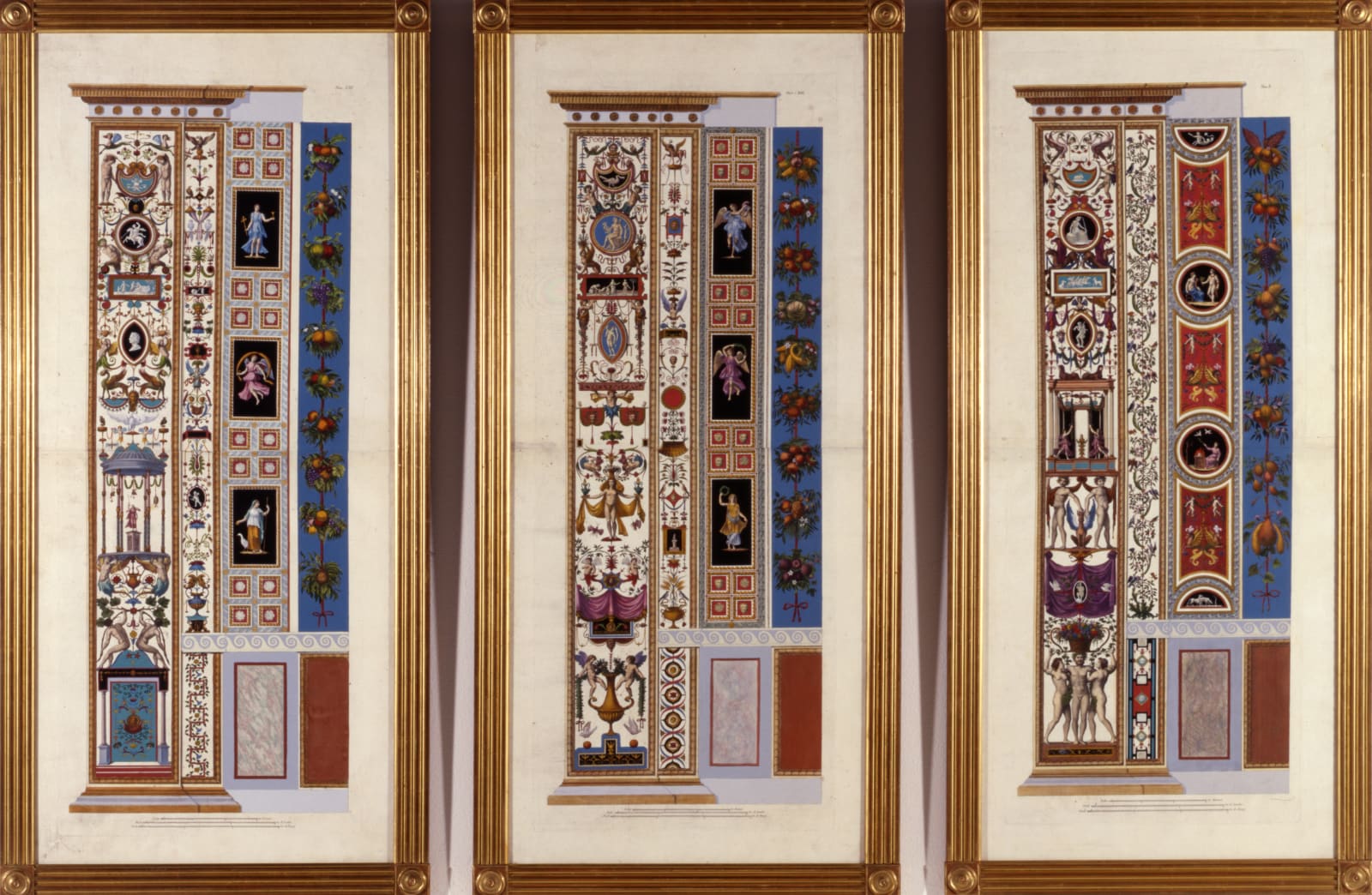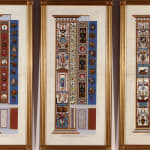Giovanni Ottaviani
Literature
Literature: engravings from a set housed at the Victoria and Albert Museum, London. "Raphael in Venit", 1985, pp. 469-475, reproducing the set of 14 similar engravings with fruit housed at the National Graphic Institute of Rome.
Six copper plate engravings with later hand colouring "Loggie di Raffaelo nel Vaticano" by Giovanni Ottaviani (1735-1808) after drawings by Pietro Camporesi (1726-81) and Gaetano Savorelli (d. 1791)
inscribed "Palmi…. tre Romani/ Piedi….di Londra / Piedi….tre di Parigi"
Published in Rome, circa 1776-1782
42 cm x 106 cm. each.
These magnificent eighteenth century hand coloured engravings by Giovanni Ottaviani after drawings by Pietro Camporesi and Gaetano Savorelli are direct renderings of the early sixteenth century grotesque decorations adorning the walls of the Loggie di Raffaelo in the Vatican Palace, Rome. Raphael (1483-1528), one of the three leading lights of the Italian High Renaissance was originally commissioned by Pope Julius II to decorate the walls and ceilings of the Loggie, which formed part of his private papal apartments in the Vatican. Raphael conceived the plans for the Loggie, consisting of 13 ceiling vaults and 52 ceiling frescoes predominately portraying Old Testament scenes. The walls, consisting of 28 pilaster frescoes, were Raphael's conception but were predominantly executed by his assistant, Giovanni da Udine during the reign of Pope Leo X. These wall panels of plants and flowers, fruit tendrils, mythological figures and fabulous creatures combined with architectural elements were something new and were directly inspired by the recently excavated ancient Roman decorations adorning Nero's Golden House on the Esquiline.
The cavernous chambers in the buried Roman ruins were popularly known as grottoes and thus decorations in paint and stucco which some of the rooms contained were consequently known as grotteschi or grotesques. These decorations astounded and alarmed a generation of artists that were familiar with the grammar of the classical orders. Until then they had no idea that in their private houses the Romans had often disregarded those rules in favour of a more fanciful and informal style that was all lightness, elegance and grace.
Raphael was one of the first artists to study and imitate the grotesque style and did so to great effect at the Vatican Loggie, where he accurately reflected all that he had learned of Roman decorative art when applied to private apartments. He was so successful that for the next 300 years his Loggie were studied by architects and decorators as reverently as the ancient ruins themselves. Even in the archaeological revival during the second half of the eighteenth century the works of architects like Robert Adam proclaimed that they had learned as much from Raphael as from Fabullus, who had originally decorated Nero's Golden Palace.
The Loggie wall decorations were completed circa 1518-19. About 250 years later Giovanni Ottaviani and another excellent engraver, Giovanni Volpato (1740-1803) received the privilege to print a series of engravings after Raphael's Loggie from Pope Clement XIII. This in itself was a large enterprise. Each of the copper plate engravings were made in two parts, based on the designs drawn by Pietro Camporesi, Gaetano Savorelli as well as Lodovico Teseo (1731-82). The whole set consisted of some 46 plates, some of which were engraved by Volpato, the others by Ottaviani. From the set of plates now housed at the National Graphic Institute of Rome it appears that 14 of the plates included hanging fruits, 13 with the fruit to right (as here) and one with vegetation the left. Each of the engravings with fruits is ascribed to Ottaviani. Although little is known of this talented engraver, he is recorded as having been born in Rome and that he studied in Venice under Joseph Wagner (1706-80). The latter was himself a tour de force, a painter and engraver who opened a school of engraving from where a number of eminent pupils arose, notably Bartolozzi, Flipart and Ottaviani.
The publication of engravings such as those by Ottaviani and Volpato had a profound influence upon the history of interior design and initiated a whole new repertoire of light and graceful motifs within the prevailing constraints of more formal Neo-classical design. Although leading designers such as Robert Adam and James 'Athenian' Stuart would have known of Nero's Golden House, which was re-excavated during the mid eighteenth century and of indeed of Raphael's interpretation of those earlier decorations, the publication of these large plates promoted renewed interest in grotesque decoration. In response, Catherine the Great of Russia and Frederic II of Prussia found the Loggie publications so compelling that they had them copied on the walls of their chateaux. Similar grotesque decorations could be seen adorning the walls of the boudoir at rue Vieille du-Temple, Paris made for Madame de Serilly, lady-in-honour to Queen Marie-Antoinette. The interior by Jean Siméon Rousseau de la Rottière, now removed to the Victoria and Albert Museum, London boasts all forms of arabesques, grotesques and fanciful figures within its distinctive vertical pilasters. Like wise wallpapers and fabrics began featuring the grotesque and arabesque designs from the Loggie. Over the years the "Loggie di Raffaelo nel Vaticano" plates have become true collector's items. While some are in museum collections others can be seen adorning the most sumptuous interiors such a set hanging on the walls of the dining room in Charlottenhof Castle, Potsdam, (illustrated in Madeleine Deschamps, "Empire", 1994, p. 203).



